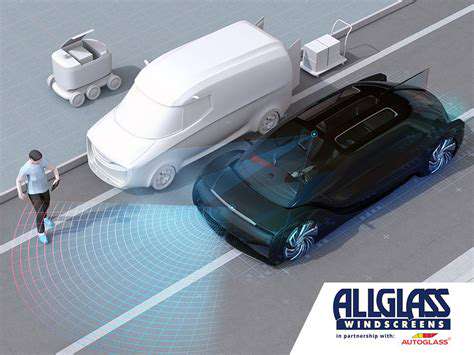
Advanced Driver-Assistance Systems (ADAS) continue to revolutionize automotive safety, blending cutting-edge technology with practical driving enhancements.
Modern vehicles now integrate networks of sensors, high-resolution cameras, and complex decision-making algorithms that constantly scan the road environment. This multi-layered safety net actively prevents accidents before they occur, representing a paradigm shift in vehicular protection. The technology's ability to anticipate dangers and initiate protective measures marks a watershed moment in automotive engineering.
Contemporary automobiles increasingly incorporate these protective systems as standard equipment. From maintaining optimal spacing between vehicles to navigating intricate urban traffic patterns, these innovations fundamentally alter our driving experience. Their continuous refinement reshapes our relationship with both vehicles and road infrastructure.
Lane monitoring technologies demonstrate ADAS's proactive safety approach.
Lane Departure Warning systems employ sophisticated camera arrays to track road markings, alerting motorists when unintended lane deviations occur. This crucial safety intervention combats accidents stemming from momentary distractions or driver fatigue, potentially preventing countless roadway tragedies annually.
Lane Keeping Assist enhances this protection by automatically making subtle steering adjustments to maintain proper lane positioning. This represents one of the most significant advancements in preventive automotive safety, substantially reducing the likelihood of dangerous lane departure incidents.
Intelligent speed regulation and collision prevention systems redefine highway safety.
Adaptive Cruise Control maintains optimal following distances by automatically adjusting vehicle speed, proving particularly valuable during extended highway journeys. This technology significantly diminishes rear-end collision risks while reducing driver fatigue on long trips.
Automatic Emergency Braking systems utilize advanced detection technologies to identify imminent collisions, applying brakes faster than human reaction times permit. These life-saving systems can mean the difference between a close call and a catastrophic accident, especially in complex urban driving scenarios.
Parking technologies and blind spot detection further enhance vehicle safety.
Modern parking assistance systems transform challenging parking maneuvers through precise sensor guidance, with some advanced versions capable of complete autonomous parking. This proves especially beneficial in tight urban environments where parking spaces come at a premium.
Blind spot monitoring employs radar technology to detect vehicles in areas invisible to drivers. These systems provide crucial warnings during lane changes, effectively eliminating one of the most common causes of highway accidents. Together, these technologies create a comprehensive safety ecosystem around modern vehicles.
How ADAS Works: The Technology Behind the Features

The Mechanics of Autonomous Driving Systems
Advanced Driver-Assistance Systems represent a technological revolution in vehicle operation, combining multiple sensor arrays with powerful computational analysis. Grasping these systems' operational principles reveals their transformative potential for road safety and transportation efficiency. These complex networks process environmental data in real-time, enabling vehicles to adapt to dynamic road conditions and prevent hazardous situations before they develop.
From basic lane monitoring to fully adaptive speed control, these systems progressively reduce driver workload while enhancing protection. Continuous technological advancements in detection systems, processing power, and machine learning algorithms drive rapid evolution in vehicle automation capabilities.
Multi-Sensor Integration: Creating a Comprehensive Environmental Model
The system's perception capabilities rely on an interconnected web of detection technologies including optical, radar, and laser-based sensors. This sensory network forms the foundation for all subsequent decision-making processes, requiring exceptional accuracy and reliability. By synthesizing data from multiple sensor types, the system builds a complete three-dimensional understanding of the vehicle's surroundings.
Different sensor technologies compensate for each other's limitations - while cameras provide detailed visual information, radar excels at distance measurement regardless of lighting conditions. This complementary approach creates a robust perception system capable of functioning in diverse driving environments and weather conditions.
Data Processing: From Raw Input to Actionable Intelligence
Sophisticated analytical algorithms transform raw sensor data into meaningful operational decisions. These programs evaluate potential hazards, assess risk levels, and determine appropriate responses. The incorporation of machine learning allows these systems to continuously improve their decision-making capabilities through accumulated driving experience and software updates.
These algorithms must distinguish between routine driving situations and genuine hazards, triggering warnings or interventions only when absolutely necessary. Their effectiveness directly determines the system's ability to prevent accidents while minimizing unnecessary driver alerts.
System Coordination: Orchestrating Complex Responses
The central processing unit serves as the technological conductor, interpreting algorithmic outputs and initiating appropriate vehicle responses. This component represents the technological nexus where perception meets action, requiring flawless coordination between all system elements. Seamless communication between subsystems ensures cohesive operation across all safety features.
Integrated ADAS features share information to develop comprehensive situational awareness, while emerging vehicle-to-vehicle communication technologies promise to extend this awareness beyond individual vehicles. This interconnected approach lays the foundation for future transportation networks where vehicles cooperate to optimize safety and traffic flow.